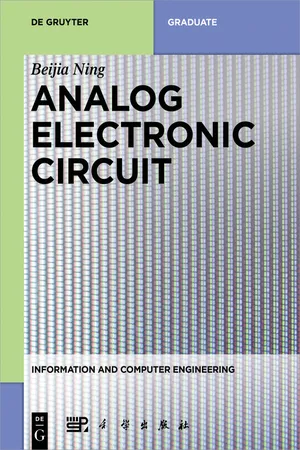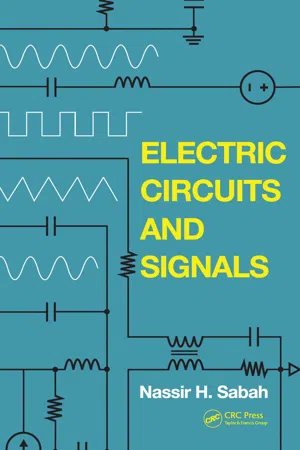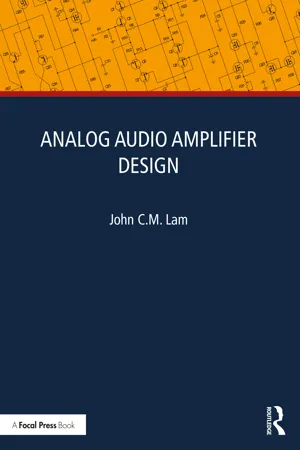Physics
Op Amp
An operational amplifier (op amp) is an electronic component that amplifies the difference in voltage between its two input terminals. It is commonly used in electronic circuits for signal processing, filtering, and mathematical operations. Op amps have high input impedance, low output impedance, and can provide high gain, making them versatile components in physics and engineering applications.
Written by Perlego with AI-assistance
Related key terms
Related key terms
1 of 4
Related key terms
1 of 3
11 Key excerpts on "Op Amp"
- eBook - ePub
- Beijia Ning, Beijia Ning(Authors)
- 2018(Publication Date)
- De Gruyter(Publisher)
5 Operational amplifiers and their applications 5.1 Overview An operational amplifier, usually abbreviated to op-amp or opamp, is a DC-coupled high-gain electronic voltage amplifier with a differential input and, normally, a single-ended output. Under this configuration, an op-amp generates an output voltage, typically hundreds of thousands of times larger than the voltage difference between its two input terminals. Operational amplifiers had their original application in analog computers for many linear and nonlinear mathematical operations [ 13 ]. The versatility of the op-amp is the reason for its popularity in analog circuits as a building block. With the help of negative feedback, the characteristics of an op-amp circuit, such as gain, bandwidth, input impedance, output impedance and so on, are manipulated by external components and have almost nothing to do with temperature change or manufacturing variations [ 12 ]. Packaged as components or used as elements of more complex integrated circuits, op-amps are one of the most widely used electronic devices today, especially in the field of analog circuits, for a wide range of applications in industrial, scientific and consumer devices. Many standard IC op-amps cost only a few cents; while some integrated or hybrid operational amplifiers with special functions may cost over US$ 100 [ 12 ]. Moreover, the op-amp is one type of differential amplifier. Other types of differential amplifier include the fully differential amplifier, the instrumentation amplifier, the isolation amplifier and the negative-feedback amplifier. However, some of these are beyond the coverage of the textbook. Briefly, the following is the historical timeline of the op-amps [ 12, 21 ]. In the 1940s, an op-amp was first invented as a “summing amplifier” by Swartzel of Bell Labs in 1941. Throughout World War II, this invention demonstrated its value, which would have been impossible for other devices - eBook - ePub
- Nassir H. Sabah(Author)
- 2017(Publication Date)
- CRC Press(Publisher)
18Signal Processing Using Operational Amplifiers
Overview
An operational amplifier, or Op Amp for short, is a high-gain voltage amplifier, designed to amplify signals in the frequency range from dc to a specified upper frequency. Operational amplifiers are so called because they were initially introduced to perform mathematical operations — such as addition, subtraction, differentiation, and integration — in analog computers that were commonly used to solve differential equations, before digital computers prevailed. Nowadays, Op Amps of high performance and low cost are widely available in integrated-circuit (IC) form, which makes them an important building block in a variety of signal-processing applications. A number of these applications are considered in this chapter.The most important feature of linear Op Amp circuits is the use of negative feedback to trade-off the high gain of the Op Amp for some desirable feature, thereby allowing such operations as precision amplification and integration. Op Amps are at the heart of active filters of various types, whose performance is superior in many respects to that of passive filters, particularly in their allowing high Q - eBook - ePub
Electronics
from Classical to Quantum
- Michael Olorunfunmi Kolawole(Author)
- 2020(Publication Date)
- CRC Press(Publisher)
4 Operational AmplifiersAs systems architectures evolve toward more complex hierarchical networks, requiring higher-performance body electronics modules and integrated circuits (ICs) to support gateway functions, as well as higher functional integration and centralized services, there is a need to explain the component parts from basic principles to empower future engineers and designers knowing and modifying the systems components as they see fit. This approach will enable the designers and engineers to migrate to higher levels of integration where essentially each electronic module connects well with the preferred system architecture. As a result, this chapter deals with the basic principles of core electronic devices starting from basic electronic operational amplifier (op-amp) characteristics and applications, including simple comparators, multivibrators, and oscillators.4.1 Basic Amplifier Definitions
An electronic amplifier is a device that responds to a small input -signal (voltage, current, or power) and delivers a larger output signal that contains the essential waveform features of the input signal. This process is technically amplification. A signal is any time-varying, or spatial-varying, quantity. The amplification of weak signals into stronger signals is of fundamental importance in almost any electronic system.The principal use of amplifiers is in the measurement process. In computer systems, for example, amplifier circuits are packaged as ICs (or chips ), performing complex tasks including mathematical operations (addition, subtraction, multiplication, integration—calculating the areas under signals, and differentiation—calculating the slopes of signals). In communication systems, for example, it may be advantageous to replace a repeater unit in an optical fiber link by a direct amplification unit, or an amplifier unit could be used in a predetection capacity at the receiver. In power and control systems, amplifiers are used as a basic building block for phase shifting, filtering and signal conditioning, multiplexing, feedback operation, to name a few applications. Technically, amplifiers that perform this kind of operations are called operational amplifiers (op-amps - eBook - ePub
Introduction to Energy, Renewable Energy and Electrical Engineering
Essentials for Engineering Science (STEM) Professionals and Students
- Ewald F. Fuchs, Heidi A. Fuchs(Authors)
- 2020(Publication Date)
- Wiley(Publisher)
8 Operational Amplifiers8.1 Introduction
The operational (OP) amplifier is a basic building block for the design of analog electronic systems such as feedback control circuits [1 ], where the angular velocity ω m (t), angular position θ m (t) = ∫ω m (t)dt, current i(t), and torque T(t) must be controlled. An Op Amplifier with no external circuitry is a voltage amplifier with a very high open‐loop voltage gain that ideally approaches infinity A v → ∞, as shown in a symbolic manner in Figure 8.1 . Note that input/output voltages can be either time varying or time independent, and they can be either periodic or nonperiodic.Op Amplifiers are integrated circuits (IC), which can be purchased off the shelf, and they contain transistors, diodes, resistors, and capacitors all fabricated on a single silicon chip. Inductors are bulky and are mostly avoided in Op Amplifier designs. The analog electronic circuit of Figure 8.1 has two inputs: a negative (v − ) and a positive (v + ) input supplied by the voltages v in1 and v in2 , respectively, whose difference in voltage (v in2 − v in1 ) produces an output signal voltage v out that is a replica of the input voltage difference. The two‐input voltage approach is useful because stray signals/electric noise that appear on both inputs are cancelled, and only the voltage difference is amplified. An Op Amplifier is also called a differential amplifier because the output voltage is a voltage that is A v times the voltage difference between the two inputs. During the past half century, Op Amplifiers have been refined and improved to the extent that they have nearly ideal properties, and therefore we discuss in this textbook the performance of ideal Op Amplifiers only. The understanding of nonideal properties of Op Amplifiers requires detailed electronic knowledge [2 - eBook - ePub
- Clive Maxfield, John Bird, Tim Williams, Walt Kester, Dan Bensky(Authors)
- 2011(Publication Date)
- Newnes(Publisher)
Chapter 11 Analog Electronics Mike Tooley and Tim WilliamsThe operational amplifier is the basic building block for analog circuits, and progress in op-amp performance is the “litmus test” for analog IC electronics technology in much the same way as progress in memory devices is for digital electronics technology. This chapter will be devoted to op-amps and comparators, with a tailpiece on voltage references.11.1 Operational Amplifiers Defined
Operational amplifiers (Figure 11.1 ) are analog integrated circuits designed for linear amplification that offer near-ideal characteristics (virtually infinite voltage gain and input resistance coupled with low output resistance and wide bandwidth).Figure 11.1 A typical operational amplifier. This device is supplied in an 8-pin dual-in-line (DIL) package. It has a JFET input stage and produces a typical open-loop voltage gain of 200,000Operational amplifiers can be thought of as universal “gain blocks” to which external components are added in order to define their function within a circuit. By adding two resistors, we can produce an amplifier having a precisely defined gain. Alternatively, with two resistors and two capacitors we can produce a simple band-pass filter. From this you might begin to suspect that operational amplifiers are really easy to use. The good news is that they are!11.2 Symbols and Connections
The symbol for an operational amplifier is shown in Figure 11.2 . There are a few things to note about this. The device has two inputs and one output and no common connection. Furthermore, we often don’t show the supply connections—it is often clearer to leave them out of the circuit altogether!Figure 11.2 Symbol for an operational amplifierIn Figure 11.2 , one of the inputs is marked “-” and the other is marked “+”. These polarity markings have nothing to do with the supply connections—they indicate the overall phase shift between each input and the output. The “+” sign indicates zero phase shift while the “-” sign indicates 180° phase shift. Since 180° phase shift produces an inverted waveform, the “-” input is often referred to as the inverting input . Similarly, the “+” input is known as the non-inverting - eBook - ePub
- Karl Stephan(Author)
- 2015(Publication Date)
- Wiley(Publisher)
5 Op Amp CIRCUITS IN ANALOG ELECTRONICS 5.1 INTRODUCTION An operational amplifier (hereafter “Op Amp”) is a specially designed amplifier that can be used in a huge number of analog-circuit applications. It is fair to say that almost anything you can do in analog electronics without Op Amps is easier, smaller, and better performing if done with Op Amps. And some things are almost impossible to do without Op Amps or their functional equivalents. Why are Op Amps so important to analog electronics (and mixed-signal electronics as well)? Because they make the use of negative feedback easy and straightforward and confer its blessings on any circuit where they are used. To understand the importance of negative feedback for Op Amps, a little history is helpful. Although the concept of negative feedback was studied by nineteenth-century physicists such as James Clerk Maxwell, negative feedback as used in electronics was developed by a Bell Labs engineer named Harold S. Black, who in the 1920s was struggling with the problem of how to improve the repeater amplifiers the Bell System was trying to use to span the US continent with long-distance telephone lines. Nonlinearities were a significant problem, because in traveling through repeaters spaced every 25 miles or so along a cable, signals encountered distortion that was tolerable in one amplifier, but which accumulated to unacceptable levels as the signals passed through dozens of amplifiers in cascade. Black realized that if he built an amplifier with much more gain than necessary and then reduced the gain by “feeding back” a portion of its output signal to the input with the proper polarity, nonlinear distortion would decrease roughly in proportion to the amount of sacrificed gain. Gain, while not free, was relatively easy to obtain simply by cascading stages, and it turned out to be a good engineering trade-off to sacrifice inexpensive gain for the much-sought-after reduction in distortion - David Terrell(Author)
- 1996(Publication Date)
- Newnes(Publisher)
Op Amps are used to amplify signals that range from DC through the higher radio frequencies (RF). The amplifier can be made to be frequency selective (i.e., act as a filter) much like the tone control on your favorite stereo system. It may be used to maintain a constant output in spite of changing input levels. The output can produce a compressed version of the input to reduce the range needed to represent a certain signal. The amplifier may respond to microvolt signals originating in a transducer, which is used to measure temperature, pressure, density, acceleration, and so on. The gain of the amplifier can be controlled by a digital computer, thus extending the power of the computer into the analog world.Oscillators.
The basic Op Amp can be connected to operate as an oscillator. The output of the oscillator may be sinusoidal, square, triangular, rectangular, sawtooth, exponential, or other shape. The frequency of oscillation may be stabilized by a crystal or controlled by a voltage or current from another circuit.Regulators.
Op Amps can be used to improve the regulation in power supplies. The actual output voltage is compared to a reference voltage and the difference is amplified by an Op Amp and used to correct the power supply output voltage. Op Amps can also be connected to regulate and/or limit the current in a power supply.Rectification.
Suppose you want to build a half-wave rectifier with a peak input signal of 150 millivolts. This is not enough to forward bias a standard silicon diode. On the other hand, an Op Amp can be configured to provide the characteristics of an ideal diode with 0 forward voltage drop. Thus it can rectify very small signals.Computer Interfaces.
The Op Amp is an integral part of many circuits used to convert analog signals representing real-world quantities (such as temperature, RPM, pressure, and so forth) into corresponding digital signals that can be manipulated by a computer. Similarly, the Op Amp is frequently used to convert the digital output of a computer into an equivalent analog form for use by industrial devices (such as motors, lights, and solenoids).Fields of Application.
Op Amps find use in such diverse fields as medical electronics, industrial electronics, agriculture, test equipment, consumer products, and automotive products. It has become a basic building block for analog systems and for the analog portion of digital systems.- eBook - ePub
- John C.M. Lam(Author)
- 2024(Publication Date)
- Focal Press(Publisher)
4Operational amplifiersDOI: 10.4324/9781003369462-44.1 Introduction
Figure 4.1 shows a diagram of an operational amplifier, which is often called an op-amp. An opamp has two inputs (inverted and non-inverted), one output, and dual power supply terminals. Some op-amps also offer two more terminals for connecting a trimmer to reduce dc offset voltage. Op-amp is a versatile electronic device that is found in almost every electronic application. A good understanding of op-amp and its applications is essential to perform the design work for audio and linear application.Diagram of an operational amplifier (op-amp)Figure4.1An ideal op-amp has the following properties [1 –3 ]:- infinite differential voltage gain;
- infinite input impedance;
- zero output impedance;
- zero input offset voltage;
- zero input bias current.
Therefore, the differential inputs of an ideal op-amp must be zero, i.e., V+ ‒ V- = 0, and the input current is also zero, i.e., I+ = 0, I- = 0. We can easily see why these must be true. If Av denotes the differential voltage gain of the op-amp, the output is given asVout =(V+-V-)AvFrom a mathematical point of view, if the differential voltage gain Av approaches infinite, the output will also approach infinite. In order to confine the output to a finite value for practical use, the term (V+ ‒ V-) must be zero. In other words, the non-inverted input and inverted input must be equal at all times, V+ = V-. On the other hand, since the input impedance is infinite, it can be easily understood that the input current must be zero, I+ = 0 and I- = 0. These properties lead to the so-called golden rules for op-amp application analysis:- non-inverted and inverted inputs are equal at all times, V+ = V-
- zero input current at all times, I+ = 0 and I- = 0
Even though an ideal op-amp does not exist in real life, the golden rules help tremendously to simplify the op-amp application analysis. After all, the results that are determined by applying the golden rules are sufficiently accurate for almost all applications. In the following, some audio and linear applications using an op-amp are discussed. - eBook - ePub
- Darren Ashby, Bonnie Baker, Ian Hickman, Walt Kester, Robert Pease, Tim Williams, Bob Zeidman(Authors)
- 2011(Publication Date)
- Newnes(Publisher)
Chapter 19
Op-Amps
Darren Ashby, Bruce Carter, Ron Mancini, Tim Williams and Bonnie Baker19.1 The Magical Mysterious Op-Amp
An operational amplifier, often called an op-amp , in my opinion, are probably the misunderstood, yet potentially useful IC at the engineer’s disposal. It makes sense that if you can understand this device you can put it to use, giving you a great advantage in designing successful products.19.1.1 What is an Op-Amp Really?
Do you understand how an op-amp works? Would you believe that op-amps were designed to make it easier to create a circuit? You probably didn’t think that the last time you were puzzling over a misbehaving breadboard in the lab.In today’s digital world, it seems to be common practice to breeze over the topic of op-amps giving the student a dusting of commonly used formulas without really explaining the purpose or theory behind them. Then, the first time an engineer designs an op-amp circuit, the result is utter confusion when the circuit doesn’t work as expected. This discussion is intended to give some insight into the guts of an operational amplifier, and to give the reader an intuitive understanding of op-amps.One last point—make sure you read this section first! It is my opinion that one of the causes of op-fusion (op-amp confusion) as I like to call it, is that the theory is taught out of order. There is a very specific order to this, so please understand each section before moving on.First, let’s take the symbol of an op-amp (Figure 19.1 ).There are two inputs, one positive and one negative, identified by the + and − signs. There is one output.Figure 19.1 Your basic op-ampThe inputs are high impedance. I repeat. The inputs are high impedance. Let me say that one more time. THE INPUTS ARE HIGH IMPEDANCE! This means they have (virtually) no effect on the circuit to which they are attached. Write this down, as it is very important. We will talk about this in more detail later. This important fact is commonly forgotten and contributes to the confusion I mentioned earlier. - Ed Lipiansky(Author)
- 2012(Publication Date)
- Wiley-IEEE Press(Publisher)
A voltage source models the offset voltage of the amplifier. The offset voltage (V OS) of the Op Amp is the voltage that is required to apply across its inputs to obtain a 0 V output with the Op Amp in an open-loop condition. Differential impedance appears across both Op Amp inputs and common mode impedance appears between the inputs and ground. This impedance models the finite common mode the real Op Amp has. Figure 5.30 depicts an Op Amp model with some real electrical parameters. Figure 5.30 Model of a real operational amplifier. The input stage has two AC current sources (I N) and an AC voltage source (V N) that model noise components that unavoidably exist in the Op Amp. Finally, for the input imperfections, we have to mention that both bias currents and offset voltages vary or drift with temperature variations. Manufacturers usually specify these parameters at one temperature, for example, at 25°C and at a range of temperatures, such as − 40°C to 85°C. Let us now talk about the output stage of the real Op Amp. The output of the Op Amp has a nonzero and finite output resistance (R o), which is modeled in series with the output generator A OL (Fig. 5.30). Generator A OL models the finite nature of the Op Amp open-loop gain. In actuality A OL is really large, but it is not infinite. The Op Amp open-loop gain is also a function of frequency, and it is usually modeled with a capacitor hanging from the output of the Op Amp to ground. This RC network at the output of the Op Amp is also referred to as the Op Amp single pole approximation. The Op Amp manufacturer specifies the device behavior with frequency with the open-loop gain bandwidth and with the Op Amp gain-bandwidth product. Both of these parameters model the frequency behavior of the Op Amp under small signal excitation. A small signal for an Op Amp is a signal whose amplitude is about one order of magnitude smaller that its supply voltage- eBook - ePub
- David Crecraft(Author)
- 2018(Publication Date)
- CRC Press(Publisher)
Fig. 4.1 b there is now no direct common connection between the input part of the circuit and the output part, because of the differential input. Actual operational amplifiers contain many transistors and other components but they are designed so that this simple equivalent circuit, which includes a Thévenin equivalent circuit at the output, is an accurate representation of their low-frequency performance.Fig 4.5 The equivalent circuit of an operational amplifier. Note that there is no common connection between the input and the output. Typically rin > 100 kΩ, rout < 1 kΩ and Av > 100 000 at low frequencies.4.3 FEEDBACK AND OPERATIONAL AMPLIFIERSOne reason why operational amplifiers are so widely used is that they can easily be converted into different kinds of amplifiers by the use of feedback, namely the connection of the output of an amplifier to its own input by some kind of circuit. The term ‘feedback’ has now become quite a common word in the general vocabulary, so that it has lost some of the more precise meaning that engineers gave it when the term was first coined. In engineering applications such as control systems, the output of the system is compared with the desired output and if there is a difference between the two, feedback is used to ensure that this information is connected into a point in the circuit in such a way that the output is brought back very close to its intended value. This is usually called negative feedback because the correction is in the opposite sense to the cause of the error.The ‘system’ containing the feedback is not necessarily an amplifier, it can be almost anything. For instance, the process of driving a car down the road is a feedback process. The output (the position and velocity of the car) is sensed by the driver and compared with his or her expectations (the input). Corrections are then made to the settings of steering wheel, the accelerator, the brake, etc., to ensure that the output conforms with the intentions of the driver. The process is one of comparing the output with the input and then adjusting the system to correct any errors.
Index pages curate the most relevant extracts from our library of academic textbooks. They’ve been created using an in-house natural language model (NLM), each adding context and meaning to key research topics.
Explore more topic indexes
Explore more topic indexes
1 of 6
Explore more topic indexes
1 of 4










